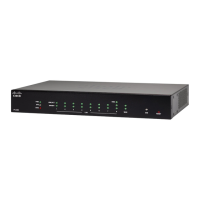Step 4 Simple Network Management Protocol (SNMP) Traps enable an agent to notify the management station of significant
events by way of an unsolicited SNMP message. To enable SNMP Traps, check Enable.
Step 5 In the Power Trap Threshold, enter the threshold in %. (Range 1 to 99, Default 95).
To configure the PoE Table, follow these steps:
The PoE Properties table displays the operational status and power levels used in the PoE.
Specify the status of the network.Operational
Status
Set the power to 60w.Nominal Power
Set the power to 0w.Consumed Power
Set the power to 15w.Allocated Power
Set the power to 0w.Available Power
Click Edit to edit the PoE Settings Table (Port Limit Mode).
The PoE Settings Table displays the levels used in the PoE.
LAN1– LAN4Port
Check to enable PoE.PoE Enable
Select a priority level (Critical, High, or Low).Power Priority Level
Enter the milliwatts (mW) (Range: 0 to 30000, Default 15000).Administrative Power Allocation
Class level setting.Class
Maximum power allocation is 30000mW.Max Power Allocation (mW)
Power consumption is set at 0mW.Power Consumption (mW)
0Overload Counter
0Short Counter
0Denied Counter
0Absent Counter
0Invalid Signature Counter
Step 6 Click OK.
VLAN Settings
On the VLAN Settings page, you can add the VLAN ID to differentiate traffic.
RV260x Administration Guide
57
LAN
VLAN Settings

